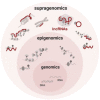Biogenesis and function of exosome lncRNAs and their role in female pathological pregnancy
- PMID: 37745705
- PMCID: PMC10515720
- DOI: 10.3389/fendo.2023.1191721
Biogenesis and function of exosome lncRNAs and their role in female pathological pregnancy
Abstract
Preeclampsia, gestational diabetes mellitus, and recurrent spontaneous abortion are common maternal pregnancy complications that seriously endanger women's lives and health, and their occurrence is increasing year after year with a rejuvenation trend. In contrast to biomarkers found freely in tissues or body fluids, exosomes exist in a relatively independent environment and provide a higher level of stability. As backbone molecules, guidance molecules, and signaling molecules in the nucleus, lncRNAs can regulate gene expression. In the cytoplasm, lncRNAs can influence gene expression levels by modifying mRNA stability, acting as competitive endogenous RNAs to bind miRNAs, and so on. Exosomal lncRNAs can exist indefinitely and are important in intercellular communication and signal transduction. Changes in maternal serum exosome lncRNA expression can accurately and timely reflect the progression and regression of pregnancy-related diseases. The purpose of this paper is to provide a reference for clinical research on the pathogenesis, diagnosis, and treatment methods of pregnancy-related diseases by reviewing the role of exosome lncRNAs in female pathological pregnancy and related molecular mechanisms.
Keywords: abortion; biomarkers; diabetes; exosome lncRNA; gestational; pre-eclampsia; pregnancy.
Copyright © 2023 Wang, Zheng, Ma, Lin, Li and Yang.
Conflict of interest statement
The authors declare that the research was conducted in the absence of any commercial or financial relationships that could be construed as a potential conflict of interest.
Figures



Similar articles
-
A comprehensive overview of exosome lncRNAs: emerging biomarkers and potential therapeutics in endometriosis.Front Endocrinol (Lausanne). 2023 Jun 26;14:1199569. doi: 10.3389/fendo.2023.1199569. eCollection 2023. Front Endocrinol (Lausanne). 2023. PMID: 37455911 Free PMC article. Review.
-
Roles of exosomes-derived lncRNAs in preeclampsia.Eur J Obstet Gynecol Reprod Biol. 2021 Aug;263:132-138. doi: 10.1016/j.ejogrb.2021.06.015. Epub 2021 Jun 19. Eur J Obstet Gynecol Reprod Biol. 2021. PMID: 34214799 Review.
-
Differential mRNA and Long Noncoding RNA Expression Profiles in Umbilical Cord Blood Exosomes from Gestational Diabetes Mellitus Patients.DNA Cell Biol. 2020 Nov;39(11):2005-2016. doi: 10.1089/dna.2020.5783. Epub 2020 Sep 28. DNA Cell Biol. 2020. PMID: 32986505
-
Exosomal ncRNAs: Novel therapeutic target and biomarker for diabetic complications.Pharmacol Res. 2022 Apr;178:106135. doi: 10.1016/j.phrs.2022.106135. Epub 2022 Feb 19. Pharmacol Res. 2022. PMID: 35192956 Review.
-
Analysis of Annotated and Unannotated Long Noncoding RNAs from Exosome Subtypes Using Next-Generation RNA Sequencing.Methods Mol Biol. 2021;2254:195-218. doi: 10.1007/978-1-0716-1158-6_12. Methods Mol Biol. 2021. PMID: 33326077
Cited by
-
Increased levels of villus-derived exosomal miR-29a-3p in normal pregnancy than uRPL patients suppresses decidual NK cell production of interferon-γ and exerts a therapeutic effect in abortion-prone mice.Cell Commun Signal. 2024 Apr 16;22(1):230. doi: 10.1186/s12964-024-01610-0. Cell Commun Signal. 2024. PMID: 38627796 Free PMC article.
-
Non-coding RNAs: the architects of placental development and pregnancy success.Mol Genet Genomics. 2025 Mar 30;300(1):39. doi: 10.1007/s00438-025-02244-8. Mol Genet Genomics. 2025. PMID: 40159439 Review.
-
Unveiling the Network regulatory mechanism of ncRNAs on the Ferroptosis Pathway: Implications for Preeclampsia.Int J Womens Health. 2024 Sep 30;16:1633-1651. doi: 10.2147/IJWH.S485653. eCollection 2024. Int J Womens Health. 2024. PMID: 39372667 Free PMC article. Review.
-
The Identification of FN1 as an Early Diagnostic Marker for Recurrent Abortion by Single-Exosome Profiling.Int J Gen Med. 2025 Feb 11;18:691-702. doi: 10.2147/IJGM.S487632. eCollection 2025. Int J Gen Med. 2025. PMID: 39963517 Free PMC article.
-
Knowledge mapping of exosomes in preeclampsia: a bibliometric analysis (2008-2023).Front Endocrinol (Lausanne). 2025 Mar 4;16:1546554. doi: 10.3389/fendo.2025.1546554. eCollection 2025. Front Endocrinol (Lausanne). 2025. PMID: 40104134 Free PMC article. Review.
References
Publication types
MeSH terms
Substances
LinkOut - more resources
Full Text Sources
Research Materials

